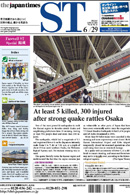Essay
Plain packaging
My Singaporean friends who smoke love smoking in Japan. It's not just because the cigarettes are cheaper (a pack of cigarettes in Singapore costs about SG$13, or ¥1,000), or because there are more choices in Japan. What my smoker friends crave the most is having a comfortable space to smoke, or at least a smoking room.
Since smoking prohibition was first introduced in Singapore in 1970, the National Environment Agency has been expanding the extensive list of smoke-free areas to include a myriad of spaces, from car parks and stairwells in residential buildings, to shopping malls and convention halls.
In March this year, the government took another step towards discouraging smoking. Stores will be banned from displaying tobacco products, and retailers have to use a text-only price list to let customers know what tobacco products are on sale.
Some countries, such as Australia, France and the U.K., have also implemented plain packaging of tobacco products to reduce consumer demand.
In fact, to mark World No Tobacco Day on May 31, the World Health Organization launched a guide to plain packaging, which points to the latest evidence and guidance on implementing the measure.
Plain packaging (also called standardized packaging) restricts or prohibits the use of logos, colours, brand images and promotional information, other than brand and product names in a standard colour and font. Packs in Singapore show the brand in their packaging, but also show graphic images of the harm cigarettes can do to your body.
WHO Director-General Dr. Margaret Chan said in a recent news release, "Plain packaging reduces the attractiveness of tobacco products. It kills the glamour ... It limits misleading packaging and labelling. And it increases the effectiveness of health warnings."
Australia has seen success in this area. Between December 2012 and September 2015, there was an additional 0.55 percentage point fall in smoking prevalence among those 14 and above — that's more than 108,000 people who either quit, didn't relapse, or didn't start smoking during this period.
I asked my smoker friends if they thought plain packaging would be effective. Most were skeptical. They felt increasing the number of smoke-free places and active law enforcement were a better deterrent. But a few said they were indeed put off by the graphic images on cigarette packs.
I see many more smokers in Japan than in Singapore, and I wonder if plain packaging would achieve its objective. Even as a non-smoker, I have been attracted by the beautiful packaging of Japanese cigarettes, albeit not to the point of actually buying and smoking them. Perhaps for seasoned smokers, plain packaging may not do much to help them kick the habit, but at least for impressionable youths, going plain may indeed be the first step to going smoke-free.
たばこのプレーン・パッケージング
日本と比べて喫煙可能な場所がかなり制限されているシンガポールでは今年3月、たばこに関する規制をさらに強化した。一方、豪州などではパッケージデザインを統一する規制も実施されている。
The Japan Times ST: July 1, 2016
The Japan Times ST 読者アンケート
この記事のご感想をお聞かせください。





